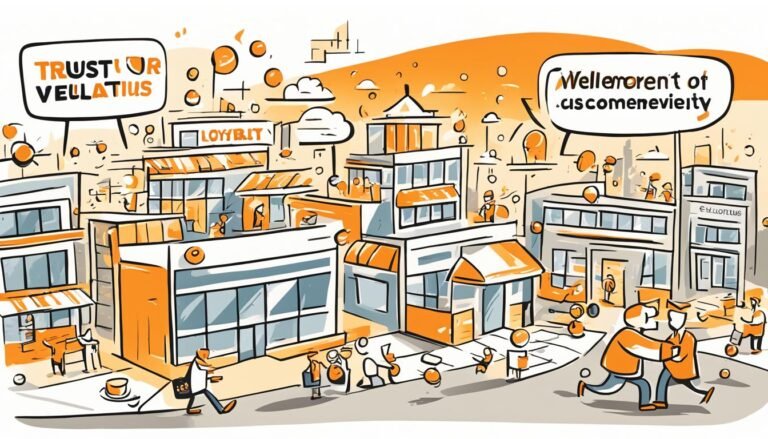Mastering Upselling and Cross-Selling Psychology
Welcome to our comprehensive guide on mastering the psychology behind upselling and cross-selling. In the world of sales, understanding consumer behavior and utilizing effective persuasion techniques are essential skills. With the right knowledge of sales psychology and strategic upselling and cross-selling strategies, you can increase your revenue and enhance the overall experience for your customers.
Key Takeaways:
- Upselling and cross-selling techniques are based on understanding consumer psychology and behavior.
- By utilizing persuasion techniques, sales professionals can encourage customers to make additional purchases.
- Segmenting your customer base allows for personalized upselling and cross-selling efforts.
- Personalization is key in effective upselling, tailoring recommendations to complement the customer’s main purchase.
- Trigger-based upselling takes advantage of specific situations to suggest upgrades or additional products.
Segmentation for Effective Upselling and Cross-Selling
To effectively implement upselling and cross-selling strategies, it is crucial to segment your customer base based on their needs, preferences, and purchase history. By dividing your customers into specific segments, you can tailor your upselling and cross-selling efforts to each group. This personalization increases the chances of success and enhances the customer experience.
Segmentation allows you to understand your customer base at a granular level. By analyzing data such as demographics, psychographics, and past purchase behavior, you can identify distinct groups within your customer base. These segments can be based on various characteristics, including age, income level, geographic location, and product preferences.
Once you have identified your customer segments, you can then create targeted upselling and cross-selling strategies for each group. For example, if you have a segment of customers who frequently purchase home decor items, you can offer them personalized recommendations for complementary products such as decorative throw pillows, wall art, or scented candles.
Segmentation Example:
Here is an example of how segmentation can be applied to upselling and cross-selling efforts:
| Customer Segment | Needs | Preferences | Purchase History |
|---|---|---|---|
| Segment A: Tech Enthusiasts | High-end gadgets and accessories | Latest technology trends | Purchased smartphones, smartwatches, and wireless earbuds |
| Segment B: Home Improvers | Home decor and improvement items | Modern and minimalist style | Purchased furniture, lighting fixtures, and kitchen appliances |
| Segment C: Fitness Fanatics | Workout equipment and activewear | Performance-focused and trendy | Purchased fitness trackers, gym accessories, and activewear |
In this example, each segment has unique needs, preferences, and purchase history. By tailoring upselling and cross-selling efforts to each segment, businesses can provide targeted offers and recommendations that align with the customers’ interests and preferences.
Segmentation enables businesses to deliver a personalized experience to their customers, making them feel valued and understood. By understanding the specific needs and preferences of each segment, businesses can increase the effectiveness of their upselling and cross-selling efforts, leading to higher conversion rates and customer satisfaction.
To learn more about the power of segmentation in upselling and cross-selling, continue reading the next section.
Segmentation allows businesses to understand their customer base at a granular level and create targeted upselling and cross-selling strategies.
Personalization for Effective Upselling
Personalization is a key factor in driving successful upselling strategies. By leveraging customer data and preferences, businesses can recommend additional products or services that complement the customer’s main purchase. These personalized upsells not only enhance the overall experience but also meet the customer’s specific needs, providing them with valuable recommendations that they are more likely to act upon.
For example, let’s say a customer purchases a premium smartphone. By analyzing their preferences and purchase history, you can personalize upsells by offering accessories such as screen protectors, phone cases, and wireless chargers. These recommendations add value to the customer’s purchase and create a customized experience tailored to their needs.
By implementing personalization strategies, businesses can accomplish the following:
- Recommend additional products or services that complement the customer’s main purchase.
- Enhance the customer’s overall experience.
- Meet the customer’s specific needs.
- Increase the likelihood of upselling success.
Personalized upselling not only generates additional revenue but also helps build trust and loyalty with customers. By proactively suggesting products or services that align with their preferences, businesses demonstrate a deep understanding of their customers’ needs, ultimately strengthening the customer-business relationship.
Personalization is the secret ingredient that transforms ordinary upselling strategies into highly effective and tailored recommendations for each individual customer. By leveraging the power of personalization, businesses can deliver a truly personalized and valuable experience, leaving a lasting impression on their customers.
So, how can businesses implement personalization effectively?
Collect and analyze customer data
Start by collecting and analyzing relevant customer data, such as purchase history, browsing behavior, and demographic information. This data will provide valuable insights into their preferences and allow you to segment your customer base effectively.
Segment your customer base
Segmenting your customer base enables you to group customers with similar needs and preferences together. This segmentation allows you to personalize your upselling efforts and recommend products or services that are most relevant to each customer segment.
Create personalized upsell offers
Based on the customer data and segmentation, proactively create personalized upsell offers that complement the customer’s main purchase. These offers should be tailored to the specific needs and preferences of each customer segment, maximizing the chances of additional purchases.
Deliver targeted recommendations
Once you have created personalized upsell offers, ensure you deliver them in a targeted way. This can be done through email marketing, personalized on-site recommendations, or even during the checkout process. The timing and placement of these recommendations are crucial to capturing the customer’s attention and encouraging them to make additional purchases.
By implementing personalization strategies, businesses can significantly enhance their upselling efforts and drive overall sales growth.
Next, we will explore trigger-based upselling, another powerful technique in maximizing upselling opportunities. Stay tuned!
Trigger-Based Upselling
In the world of sales, identifying opportunities for upselling is crucial for maximizing revenue. One effective approach is trigger-based upselling, where specific triggers act as signals for suggesting upgrades to customers. By leveraging these triggers, businesses can capitalize on moments when customers are most receptive to additional offerings.
Identifying Opportunities:
Triggers can take various forms, such as milestones or relevant problems encountered by customers. For example, when a customer reaches a milestone, like completing a certain number of transactions or reaching a specific membership tier, it presents an opportunity for upselling. Similarly, when a customer experiences a relevant problem that can be solved with an upgrade, it creates a window for suggesting enhancements in their existing products or services.
Suggesting Upgrades:
Once an opportunity is identified, businesses can suggest relevant upgrades to customers. This can be done through automated messages or personalized recommendations, depending on the context and customer preferences. By tailoring the upsell suggestions to each customer’s unique needs and preferences, businesses increase the chances of closing the sale and enhancing customer satisfaction.
“Trigger-based upselling helps businesses capitalize on opportune moments, guiding customers towards higher-value purchases and optimizing their overall experience.”
To illustrate the concept further, let’s consider a common example in the software subscription industry. Suppose a customer has exceeded their current storage limit. In this scenario, the business can trigger an automated message recommending an upsell to a higher storage tier. This proactive approach not only addresses the customer’s immediate needs but also boosts the value of their subscription.
Benefits of Trigger-Based Upselling:
Implementing trigger-based upselling can yield significant benefits for businesses:
- Increased Revenue: By capitalizing on specific triggers, businesses can guide customers towards higher-value purchases, leading to increased revenue.
- Enhanced Customer Experience: Through personalized recommendations, businesses can provide tailored solutions to customers, improving their overall experience.
- Improved Customer Retention: Upselling based on triggers demonstrates proactive customer care, strengthening the relationship and encouraging long-term loyalty.
| Benefits of Trigger-Based Upselling | |
|---|---|
| Increased Revenue | Increase in sales through upselling |
| Enhanced Customer Experience | Personalized recommendations that address customer needs |
| Improved Customer Retention | Proactive customer care that strengthens relationships |
In summary, trigger-based upselling offers businesses a powerful approach to identify opportunities, suggest upgrades, and maximize revenue. By leveraging automated messages and personalized recommendations, companies can guide customers towards higher-value purchases, enhancing both their experience and the bottom line.
Value Bundling for Effective Cross-Selling
Value bundling is a highly effective strategy for cross-selling, as it offers customers a bundled package that provides more value than purchasing individual items separately. These bundled packages not only save customers money but also offer convenience, making them an attractive option.
When customers can obtain multiple products or services at a slightly lower cost than buying each item individually, they are more likely to make additional purchases. This win-win situation provides customers with cost savings while increasing sales opportunities for businesses.
As an example, let’s consider the streaming service industry. Instead of subscribing to multiple streaming platforms individually, customers can opt for a bundled package that includes access to several platforms at a slightly reduced cost. This encourages customers to fulfill their entertainment needs in one place, providing them with more value and convenience.
Benefits of Value Bundling for Cross-Selling:
- Cost Savings: Bundled packages offer customers the opportunity to save money compared to purchasing each item separately.
- More Value: Customers receive multiple products or services that complement each other, enhancing their overall experience.
- Convenience: Bundled packages simplify the purchasing process, allowing customers to acquire what they need in one transaction.
By leveraging the power of value bundling, businesses can effectively increase cross-selling opportunities, drive more sales, and satisfy customer needs for convenience and cost savings.
Comparison of Value Bundled Packages vs. Individual Purchases
| Individual Purchases | Value Bundled Package | Benefits |
|---|---|---|
| Product A ($50) | Product A ($50) | – |
| Product B ($30) | Product B ($30) | – |
| Product C ($20) | Product C ($20) | – |
| – | Product D ($10) | More value for the same price |
| – | Product E ($15) | Cost savings |
| Total: $100 | Total: $75 | Convenience and cost savings |
As shown in the table above, a value bundled package offers customers the same products in combination with additional items, all at a lower total cost. This not only provides customers with more value but also represents a cost-saving opportunity that encourages them to make cross-purchases. The convenience of a bundled package allows customers to fulfill their needs efficiently.
“With value bundling, customers can enjoy a seamless and cost-effective way to experience the full range of products and services that meet their needs.”
By implementing value bundling strategies, businesses can successfully cross-sell a range of products or services, while providing customers with cost savings and convenience. This approach enhances the overall customer experience and ultimately leads to increased sales and customer satisfaction.
Loyalty Programs for Cross-Selling
Loyalty programs can be a powerful tool for cross-selling. By rewarding loyal customers with exclusive offers, early access to new products, or special discounts on complementary items, you can encourage them to make additional purchases.
For example, a fashion store can offer loyalty program members a discount on matching accessories when they purchase a new outfit. This not only enhances the customer’s experience but also provides an extra incentive to join the loyalty program.
In addition to encouraging repeat purchases, loyalty programs also contribute to increased customer satisfaction and retention. By making customers feel valued and appreciated, you cultivate a sense of loyalty and foster long-term relationships.
Here’s an example of how a clothing retailer can structure their loyalty program:
| Loyalty Program Tiers | Benefits |
|---|---|
| Gold | – 10% off on all purchases – Exclusive access to pre-sales – Free shipping on all orders |
| Silver | – 5% off on all purchases – Access to select sales – Free shipping on orders above $50 |
| Bronze | – 3% off on all purchases – Occasional discounts – Free shipping on orders above $100 |
By offering different tiers with varying benefits, the retailer can incentivize customers to spend more in order to enjoy exclusive perks. This encourages cross-selling by giving customers additional reasons to explore different product categories within the store.
Overall, loyalty programs are an effective way to reward and retain loyal customers while promoting cross-selling. Not only do they drive additional sales, but they also foster a sense of loyalty and satisfaction among customers, ensuring the long-term success of your business.
Leveraging Customer Feedback for Cross-Selling and Upselling
Customer feedback is an invaluable resource when it comes to identifying opportunities for cross-selling and upselling. By proactively seeking and analyzing customer feedback, businesses can gain valuable insights into customer preferences and behaviors, allowing them to identify potential cross-selling and upselling opportunities.
One effective way to analyze customer feedback is to identify recurring themes or patterns. For example, if a restaurant frequently receives praise for a signature dish, this feedback can be leveraged to create a “Chef’s Specials” menu that features dishes that pair perfectly with the star dish. By sharing these recommendations with customers, the restaurant can increase cross-selling and upselling opportunities.
Here’s an example of how a Chef’s Specials menu can be structured:
| Dish | Description |
|---|---|
| Signature Dish | The restaurant’s most popular and highly-rated dish. |
| Chef’s Special 1 | A unique creation by the chef, specially designed to complement the flavors of the signature dish. |
| Chef’s Special 2 | Another delicious option handcrafted by the chef, chosen to elevate the dining experience. |
By offering these curated recommendations to customers who have expressed their satisfaction with the signature dish, the restaurant can enhance their dining experience and increase sales. The Chef’s Specials menu serves as a strategic tool for cross-selling and upselling, highlighting additional dishes that customers may not have considered otherwise.
In situations where businesses receive feedback that indicates a desire or need for certain complementary products or services, these insights can be used to formulate effective cross-selling strategies. For instance, if a software company’s customers frequently express the need for integration with a specific tool, the company can upsell a package that includes the desired integration feature.
By leveraging customer feedback, businesses can identify opportunities for cross-selling and upselling that align with their customers’ preferences and needs. This not only leads to increased revenue but also enhances the overall customer experience.

Customer feedback is a powerful tool to drive business growth and build customer loyalty. Make the most out of this valuable resource by actively seeking, analyzing, and implementing insights from customer feedback.
Creating Urgency for Effective Cross-Selling and Upselling
Creating a sense of urgency is a powerful strategy when it comes to cross-selling and upselling. By offering time-limited promotions, such as flash sales or limited-time discounts, businesses can encourage customers to act swiftly and make additional purchases. The fear of missing out on a great deal or exclusive offer can drive immediate action from customers, increasing the chances of cross-selling success.
Imagine an e-commerce business running a flash sale, where customers who purchase a particular product within the next 24 hours receive a discount on a complementary item. This creates a sense of urgency, compelling customers to take advantage of the offer before it expires. By leveraging time-limited promotions, businesses can seize the attention of customers and inspire them to make immediate cross-selling decisions.
To illustrate this concept, let’s take a look at an example:
| Product | Regular Price | Flash Sale Discount | Complementary Item Discount |
|---|---|---|---|
| Shoes | $100 | 20% off | 15% off on socks |
In this scenario, customers who purchase a pair of shoes at the regular price of $100 during the flash sale can enjoy a 20% discount. Additionally, if they take immediate action and purchase a pair of socks along with the shoes, they can receive an extra 15% discount on the socks. This irresistible offer not only creates a sense of urgency but also entices customers to maximize their savings by purchasing both items together.
By using time-limited offers, businesses can tap into customers’ desire for immediate gratification and drive cross-selling success. The limited-time nature of these promotions increases perceived value and urgency, compelling customers to act quickly. Whether it’s a flash sale, a limited-time bundle offer, or an exclusive discount on complementary products, creating a sense of urgency is crucial in maximizing cross-selling opportunities.
Continue reading to discover the power of cross-selling and upselling in the eCommerce industry and how these strategies can significantly boost revenue and enhance customer satisfaction.
The Power of Cross-Selling and Upselling in eCommerce
Cross-selling and upselling are powerful techniques that can significantly increase revenue in the eCommerce industry. By implementing these strategies, businesses can not only drive additional sales but also enhance the overall customer experience, increase customer retention, and improve customer satisfaction.
Enhancing Customer Experience with Personalized Recommendations
One effective way to improve customer experience and drive cross-selling and upselling is through personalized recommendations. By analyzing customer data and purchasing history, businesses can offer relevant product suggestions to their customers. Personalized upsells that complement the customer’s main purchase not only meet their specific needs but also enhance their overall experience, increasing the likelihood of additional sales.
Value Bundling to Encourage Cross-Selling
Value bundling is another effective strategy for cross-selling in eCommerce. By creating bundled packages that offer more value and cost savings than individual items purchased separately, businesses can entice customers to make additional purchases. These bundled packages provide convenience and a comprehensive solution to customers, enhancing their shopping experience and driving cross-selling opportunities.
Loyalty Programs for Customer Retention and Cross-Selling
Loyalty programs play a crucial role in both customer retention and cross-selling efforts. By rewarding loyal customers with exclusive offers, special discounts, or early access to new products, businesses can incentivize repeat purchases and encourage customers to explore complementary items. By leveraging loyalty programs, businesses can strengthen customer relationships and boost cross-selling success.
Leveraging Customer Feedback for Continuous Improvement
Customer feedback is invaluable in identifying opportunities for cross-selling and upselling. By actively seeking and analyzing customer feedback, businesses can gain insights into customer preferences, pain points, and unmet needs. This information can then be used to tailor cross-selling and upselling efforts, providing customers with targeted recommendations that align with their preferences, increasing customer satisfaction, and driving additional revenue.
Creating Urgency to Drive Immediate Action
Creating a sense of urgency can be a highly effective technique for encouraging cross-selling and upselling in eCommerce. By offering time-limited promotions, such as flash sales or limited-time discounts, businesses can motivate customers to take immediate action and make additional purchases. These time-sensitive offers create a fear of missing out and often lead to increased conversion rates and revenue.
Implementing cross-selling and upselling strategies in eCommerce is essential for business growth. By enhancing the customer experience through personalized recommendations, value bundling, loyalty programs, leveraging feedback, and creating a sense of urgency, businesses can significantly increase revenue, improve customer retention, and drive customer satisfaction. These strategies contribute to long-term success in the ever-evolving eCommerce industry.
Conclusion
Mastering the psychology of upselling and cross-selling is crucial for sales professionals looking to drive revenue and enhance customer relationships. By implementing practical strategies such as segmentation, personalization, trigger-based upselling, value bundling, loyalty programs, leveraging customer feedback, and creating urgency, salespeople can maximize their sales performance. These strategies not only lead to increased revenue but also provide customers with a valuable and personalized experience.
Segmentation allows sales professionals to tailor their upselling and cross-selling efforts to each customer group, ensuring a more targeted approach. Personalization enhances the upselling strategy by recommending additional products or services that complement the customer’s main purchase, delivering a personalized experience.
Trigger-based upselling identifies opportunities to suggest upgrades by leveraging customer milestones or relevant problems. Value bundling, on the other hand, attracts customers to make additional purchases by offering bundled packages that provide more value and convenience. Loyalty programs incentivize customers to cross-sell by offering exclusive offers and special discounts to reward their loyalty.
Leveraging customer feedback helps identify cross-selling and upselling opportunities, while creating a sense of urgency through time-limited offers increases the likelihood of additional purchases. By adopting these proven techniques, sales professionals can achieve tangible results, drive revenue growth, increase customer satisfaction, and provide a highly personalized experience for their valued customers.







